Configuring IPSec LAN-to-LAN tunnel between the Cisco Pix Firewall and a NetScreen Firewall
Available Languages
Contents
Introduction
This document describes the necessary procedure used to create an IPsec LAN-to-LAN tunnel between a Cisco PIX Firewall and a NetScreen Firewall with the latest software. There is a private network behind each device that communicates to the other firewall through the IPsec tunnel.
Prerequisites
Requirements
Ensure that you meet these requirements before you attempt this configuration:
-
The NetScreen Firewall is configured with the IP addresses on the trust/untrust interfaces.
-
Connectivity is established to the Internet.
Components Used
The information in this document is based on these software and hardware versions:
-
PIX Firewall Software Version 6.3(1)
-
NetScreen Latest Revision
The information in this document was created from the devices in a specific lab environment. All of the devices used in this document started with a cleared (default) configuration. If your network is live, make sure that you understand the potential impact of any command.
Conventions
Refer to the Cisco Technical Tips Conventions for more information on document conventions.
Configure
In this section, you are presented with the information to configure the features described in this document.
Note: Use the Command Lookup Tool (registered customers only) to obtain more information on the commands used in this section.
Network Diagram
This document uses this network setup:

Configurations
This document uses these configurations:
Configure the PIX Firewall
| PIX Firewall |
|---|
PIX Version 6.3(1) interface ethernet0 10baset interface ethernet1 100full nameif ethernet0 outside security0 nameif ethernet1 inside security100 enable password 8Ry2YjIyt7RRXU24 encrypted passwd 2KFQnbNIdI.2KYOU encrypted hostname pixfirewall domain-name cisco.com fixup protocol ftp 21 fixup protocol h323 h225 1720 fixup protocol h323 ras 1718-1719 fixup protocol http 80 fixup protocol ils 389 fixup protocol rsh 514 fixup protocol rtsp 554 fixup protocol sip 5060 fixup protocol sip udp 5060 fixup protocol skinny 2000 fixup protocol smtp 25 fixup protocol sqlnet 1521 names !--- Access control list (ACL) for interesting traffic to be encrypted and !--- to bypass the Network Address Translation (NAT) process. access-list nonat permit ip 10.0.25.0 255.255.255.0 10.0.3.0 255.255.255.0 pager lines 24 logging on logging timestamp logging buffered debugging icmp permit any inside mtu outside 1500 mtu inside 1500 !--- IP addresses on the interfaces. ip address outside 172.18.124.96 255.255.255.0 ip address inside 10.0.25.254 255.255.255.0 ip audit info action alarm ip audit attack action alarm pdm logging informational 100 pdm history enable arp timeout 14400 global (outside) 1 interface !--- Bypass of NAT for IPsec interesting inside network traffic. nat (inside) 0 access-list nonat nat (inside) 1 0.0.0.0 0.0.0.0 0 0 !--- Default gateway to the Internet. route outside 0.0.0.0 0.0.0.0 172.18.124.1 1 timeout xlate 0:05:00 timeout conn 1:00:00 half-closed 0:10:00 udp 0:02:00 rpc 0:10:00 h225 1:00:00 timeout h323 0:05:00 mgcp 0:05:00 sip 0:30:00 sip_media 0:02:00 timeout uauth 0:05:00 absolute aaa-server TACACS+ protocol tacacs+ aaa-server RADIUS protocol radius aaa-server LOCAL protocol local http 10.0.0.0 255.0.0.0 inside no snmp-server location no snmp-server contact snmp-server community public no snmp-server enable traps floodguard enable !--- This command avoids applied ACLs or conduits on encrypted packets. sysopt connection permit-ipsec !--- Configuration of IPsec Phase 2. crypto ipsec transform-set mytrans esp-3des esp-sha-hmac crypto map mymap 10 ipsec-isakmp crypto map mymap 10 match address nonat crypto map mymap 10 set pfs group2 crypto map mymap 10 set peer 172.18.173.85 crypto map mymap 10 set transform-set mytrans crypto map mymap interface outside !--- Configuration of IPsec Phase 1. isakmp enable outside !--- Internet Key Exchange (IKE) pre-shared key !--- that the peers use to authenticate. isakmp key testme address 172.18.173.85 netmask 255.255.255.255 isakmp identity address isakmp policy 10 authentication pre-share isakmp policy 10 encryption 3des isakmp policy 10 hash sha isakmp policy 10 group 2 isakmp policy 10 lifetime 86400 telnet timeout 5 ssh timeout 5 console timeout 0 dhcpd lease 3600 dhcpd ping_timeout 750 terminal width 80 |
Configure the NetScreen Firewall
Complete these steps in order to configure the NetScreen Firewall.
-
Select Lists > Address, go to the Trusted tab, and click New Address.
-
Add the NetScreen internal network that is encrypted on the tunnel and click OK.
Note: Ensure that the Trust option is selected.
This example uses network 10.0.3.0 with a mask of 255.255.255.0.
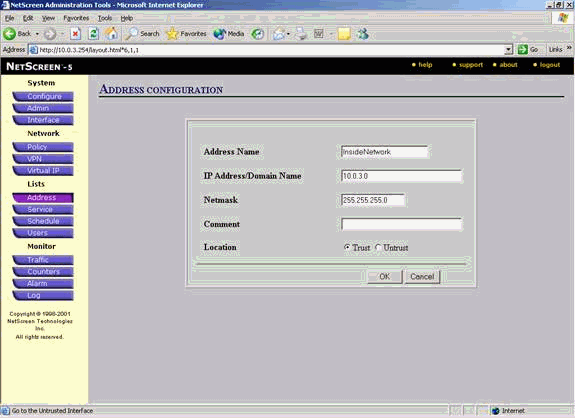
-
Select Lists > Address, go to the Untrusted tab, and click New Address.
-
Add the remote network that NetScreen Firewall uses when it encrypts packets and click OK.
Note: Do not use address groups when you configure a VPN to a non NetScreen gateway. VPN interoperability fails if you use address groups. The non NetScreen security gateway does not know how to interpret the proxy ID created by NetScreen when address group is used.
There are couple of workarounds for this:
-
Separate the address groups into individual address book entries. Specify individual policies on a per address book entry basis.
-
Configure proxy ID to be 0.0.0.0/0 on the non NetScreen gateway (firewall device) if possible.
This example uses network 10.0.25.0 with a mask of 255.255.255.0.
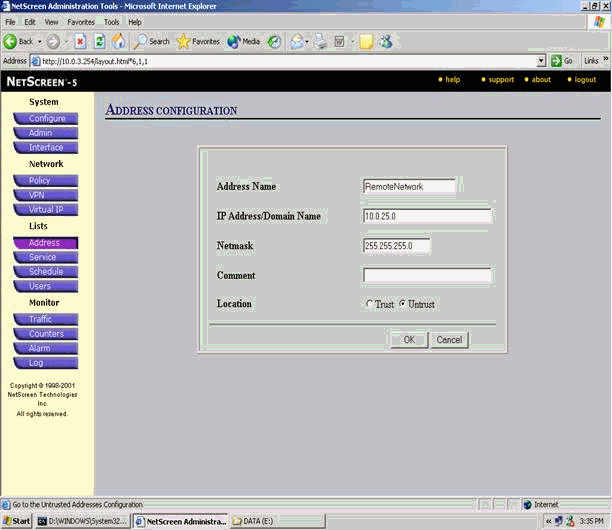
-
-
Select Network > VPN, go to the Gateway tab, and click New Remote Tunnel Gateway to configure the VPN gateway (Phase 1 and Phase 2 IPsec policies).
-
Use the IP address of the PIX's outside interface in order to terminate the tunnel, and configure the Phase 1 IKE options to bind. Click OK when you are finished.
This example uses these fields and values.
-
Gateway Name: To501
-
Static IP Address: 172.18.124.96
-
Mode: Main (ID Protection)
-
Preshared Key: "testme"
-
Phase 1 proposal: pre-g2-3des-sha
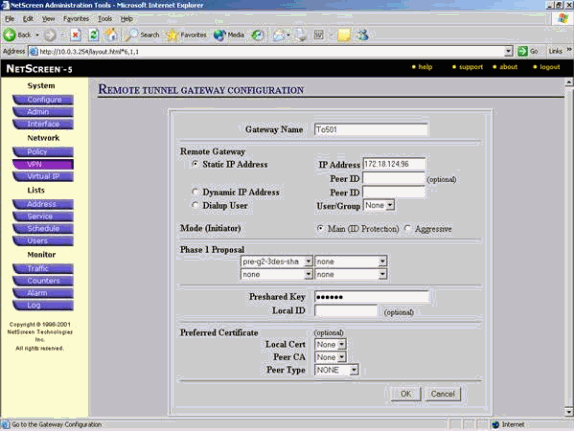
When the remote tunnel gateway is successfully created, a screen similar to this appears.
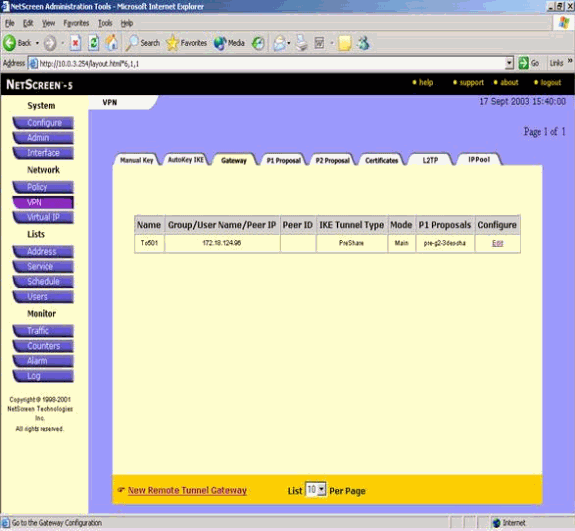
-
-
Go to the P1 Proposal tab and click New Phase 1 Proposal to configure Proposal 1.
-
Enter the configuration information for the Phase 1 Proposal and click OK.
This example uses these fields and values for Phase 1 exchange.
-
Name: ToPix501
-
Authentication: Preshare
-
DH Group: Group 2
-
Encryption: 3DES-CBC
-
Hash: SHA-1
-
Lifetime: 3600 Sec.
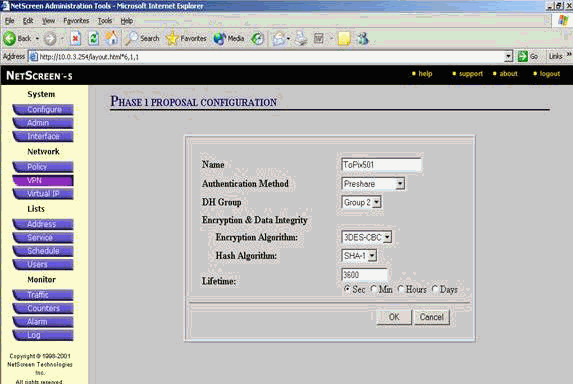
When Phase 1 is successfully added to the NetScreen configuration, a screen similar to this example appears.
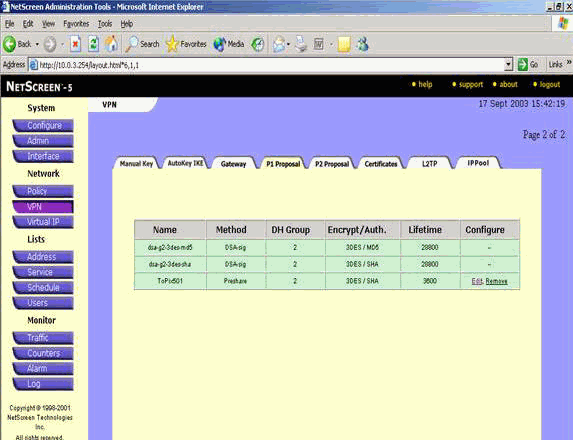
-
-
Go to the P2 Proposal tab and click New Phase 2 Proposal to configure Phase 2.
-
Enter the configuration information for the Phase 2 Proposal and click OK.
This example uses these fields and values for Phase 2 exchange.
-
Name: ToPix501
-
Perfect Forward Secrecy: DH-2 (1024 bits)
-
Encryption Algorithm: 3DES-CBC
-
Authentication Algorithm: SHA-1
-
Lifetime: 26400 Sec
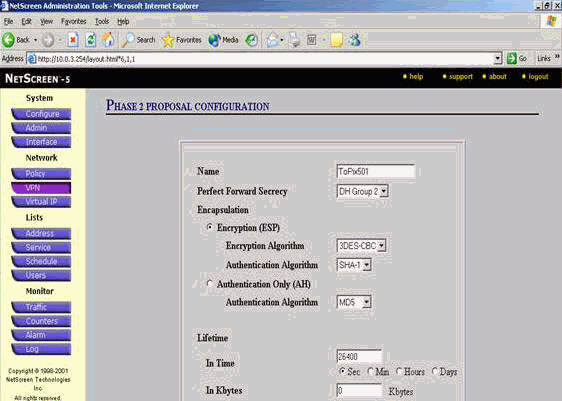
When Phase 2 is successfully added to the NetScreen configuration, a screen similar to this example appears.
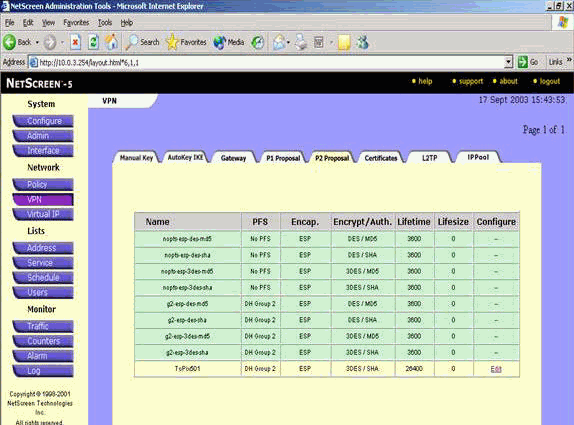
-
-
Select the AutoKey IKE tab, and then click New AutoKey IKE Entry to create and configure AutoKeys IKE.
-
Enter the configuration information for AutoKey IKE, and then click OK.
This example uses these fields and values for AutoKey IKE.
-
Name: VPN-1
-
Remote Gateway Tunnel Name: To501
(This was previously created on the Gateway tab.)
-
Phase 2 Proposal: ToPix501
(This was previously created on the P2 Proposal tab.)
-
VPN Monitor: Enable
(This enables the NetScreen device to set Simple Network Management Protocol [SNMP] traps in order to monitor the condition of the VPN Monitor.)
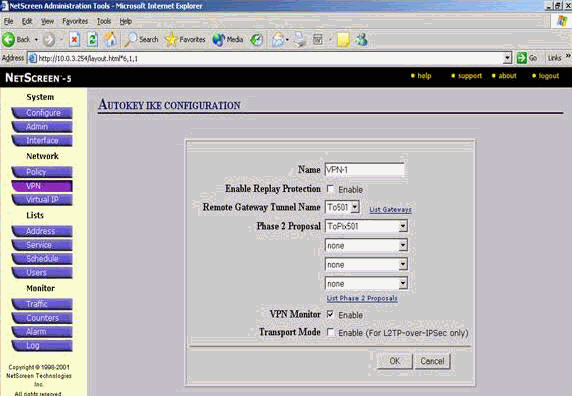
When the VPN-1 rule is successfully configured, a screen similar to this example appears.
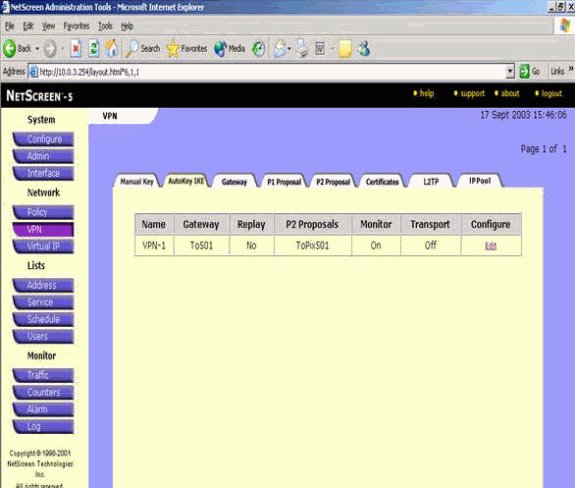
-
-
Select Network > Policy, go to the Outgoing tab, and click New Policy to configure the rules that allow encryption of the IPsec traffic.
-
Enter the configuration information for the policy and click OK.
This example uses these fields and values for the policy. The Name field is optional and is not used in this example.
-
Source Address: InsideNetwork
(This was previously defined on the Trusted tab.)
-
Destination Address: RemoteNetwork
(This was previously defined under the Untrusted tab.)
-
Service: Any
-
Action: Tunnel
-
VPN Tunnel: VPN-1
(This was previously defined as the VPN tunnel on the AutoKey IKE tab.)
-
Modify matching incoming VPN policy: Checked
(This option automatically creates an inbound rule that matches the outside network VPN traffic.)
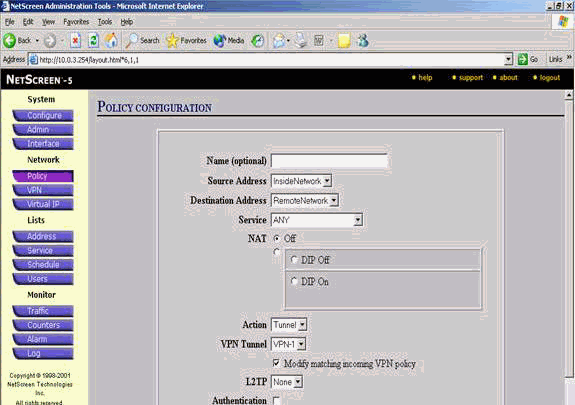
-
-
When the policy is added, ensure that the outbound VPN rule is first in the list of policies. (The rule that is created automatically for inbound traffic is on the Incoming tab.)
Complete these steps if you need to change the order of the policies:
-
Click the Outgoing tab.
-
Click the circular arrows in the Configure column in order to display the Move Policy Micro window.
-
Change the order of the policies so that the VPN policy is above policy ID 0 (so that the VPN policy is at the top of the list).
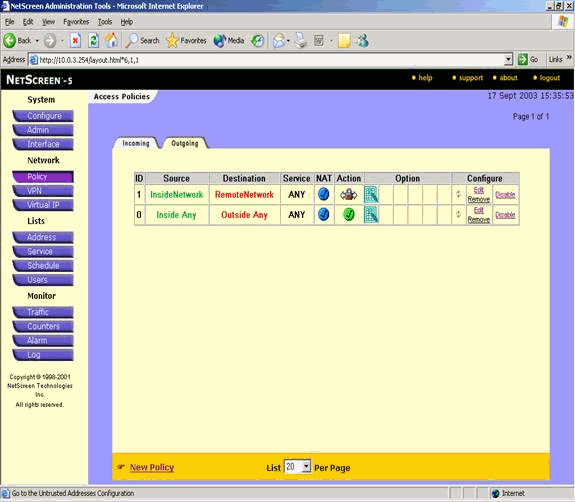
Go to the Incoming tab in order to view the rule for inbound traffic.
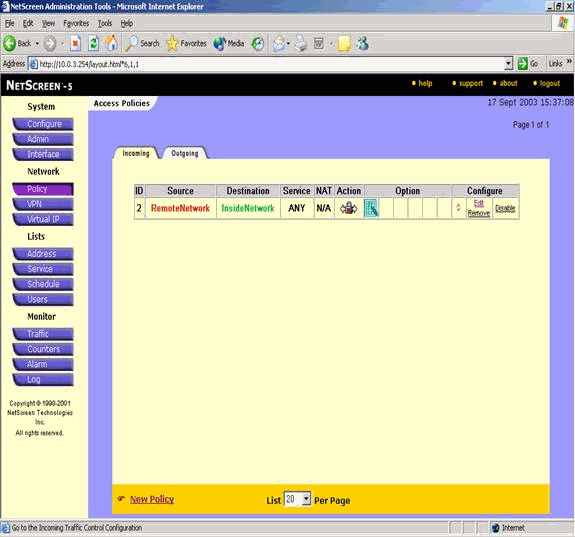
-
Verify
This section provides information you can use to confirm your configuration properly works.
Verification Commands
The Output Interpreter Tool (registered customers only) (OIT) supports certain show commands. Use the OIT to view an analysis of show command output.
-
ping—Diagnoses basic network connectivity.
-
show crypto ipsec sa—Shows the Phase 2 security associations.
-
show crypto isakmp sa—Shows the Phase 1 security associations.
Verification Output
Sample output from ping and show commands is shown here.
This ping is initiated from a host behind the NetScreen Firewall.
C:\>ping 10.0.25.1 -t Request timed out. Request timed out. Reply from 10.0.25.1: bytes=32 time<105ms TTL=128 Reply from 10.0.25.1: bytes=32 time<114ms TTL=128 Reply from 10.0.25.1: bytes=32 time<106ms TTL=128 Reply from 10.0.25.1: bytes=32 time<121ms TTL=128 Reply from 10.0.25.1: bytes=32 time<110ms TTL=128 Reply from 10.0.25.1: bytes=32 time<116ms TTL=128 Reply from 10.0.25.1: bytes=32 time<109ms TTL=128 Reply from 10.0.25.1: bytes=32 time<110ms TTL=128 Reply from 10.0.25.1: bytes=32 time<118ms TTL=128
Output from the show crypto ipsec sa command is shown here.
pixfirewall(config)#show crypto ipsec sa
interface: outside
Crypto map tag: mymap, local addr. 172.18.124.96
local ident (addr/mask/prot/port):
(10.0.25.0/255.255.255.0/0/0)
remote ident (addr/mask/prot/port):
(10.0.3.0/255.255.255.0/0/0)
current_peer: 172.18.173.85:500
PERMIT, flags={origin_is_acl,}
#pkts encaps: 11, #pkts encrypt: 11, #pkts digest 11
#pkts decaps: 11, #pkts decrypt: 13, #pkts verify 13
#pkts compressed: 0, #pkts decompressed: 0
#pkts not compressed: 0, #pkts compr. failed: 0,
#pkts decompress failed: 0, #send errors 0, #recv errors 1
local crypto endpt.: 172.18.124.96,
remote crypto endpt.: 172.18.173.85
path mtu 1500, ipsec overhead 56, media mtu 1500
current outbound spi: f0f376eb
inbound esp sas:
spi: 0x1225ce5c(304467548)
transform: esp-3des esp-sha-hmac ,
in use settings ={Tunnel, }
slot: 0, conn id: 3, crypto map: mymap
sa timing: remaining key lifetime (k/sec):
(4607974/24637)
IV size: 8 bytes
replay detection support: Y
inbound ah sas:
inbound pcp sas:
outbound esp sas:
spi: 0xf0f376eb(4042487531)
transform: esp-3des esp-sha-hmac ,
in use settings ={Tunnel, }
slot: 0, conn id: 4, crypto map: mymap
sa timing: remaining key lifetime (k/sec):
(4607999/24628)
IV size: 8 bytes
replay detection support: Y
outbound ah sas:
outbound pcp sas:
Output from the show crypto isakmp sa command is shown here.
pixfirewall(config)#show crypto isakmp sa
Total : 1
Embryonic : 0
dst src state pending created
172.18.124.96 172.18.173.85 QM_IDLE 0 1
Troubleshoot
This section provides information you can use to troubleshoot your configuration.
Troubleshooting Commands
Note: Refer to Important Information on Debug Commands before you use debug commands.
-
debug crypto engine—Displays messages about crypto engines.
-
debug crypto ipsec—Displays information about IPsec events.
-
debug crypto isakmp—Displays messages about IKE events.
Sample Debug Output
Sample debug output from the PIX Firewall is shown here.
debug crypto engine
debug crypto ipsec
debug crypto isakmp
crypto_isakmp_process_block:src:172.18.173.85,
dest:172.18.124.96 spt:500 dpt:500
OAK_MM exchange
ISAKMP (0): processing SA payload. message ID = 0
ISAKMP (0): Checking ISAKMP transform 1 against priority 10 policy
ISAKMP: encryption 3DES-CBC
ISAKMP: hash SHA
ISAKMP: default group 2
ISAKMP: auth pre-share
ISAKMP: life type in seconds
ISAKMP: life duration (basic) of 28800
ISAKMP (0): atts are acceptable. Next payload is 0
ISAKMP (0): processing vendor id payload
ISAKMP (0): processing vendor id payload
ISAKMP (0): SA is doing pre-shared key authentication
using id type ID_IPV4_ADDR
return status is IKMP_NO_ERROR
crypto_isakmp_process_block:src:172.18.173.85,
dest:172.18.124.96 spt:500 dpt:500
OAK_MM exchange
ISAKMP (0): processing KE payload. message ID = 0
ISAKMP (0): processing NONCE payload. message ID = 0
return status is IKMP_NO_ERROR
crypto_isakmp_process_block:src:172.18.173.85,
dest:172.18.124.96 spt:500 dpt:500
OAK_MM exchange
ISAKMP (0): processing ID payload. message ID = 0
ISAKMP (0): processing HASH payload. message ID = 0
ISAKMP (0): SA has been authenticated
ISAKMP (0): ID payload
next-payload : 8
type : 1
protocol : 17
port : 500
length : 8
ISAKMP (0): Total payload length: 12
return status is IKMP_NO_ERROR
ISAKMP (0): sending INITIAL_CONTACT notify
ISAKMP (0): sending NOTIFY message 24578 protocol 1
VPN Peer: ISAKMP: Added new peer: ip:172.18.173.85/500
Total VPN Peers:1
VPN Peer: ISAKMP: Peer ip:172.18.173.85/500 Ref cnt
incremented to:1
Total VPN Peers:1
crypto_isakmp_process_block:src:172.18.173.85,
dest:172.18.124.96 spt:500 dpt:500
ISAKMP (0): processing DELETE payload. message ID = 534186807,
spi size = 4IPSEC(key_engin
e): got a queue event...
IPSEC(key_engine_delete_sas): rec'd delete notify from ISAKMP
IPSEC(key_engine_delete_sas):
delete all SAs shared with 172.18.173.85
return status is IKMP_NO_ERR_NO_TRANS
crypto_isakmp_process_block:src:172.18.173.85,
dest:172.18.124.96 spt:500 dpt:500
OAK_QM exchange
oakley_process_quick_mode: OAK_QM_IDLE
ISAKMP (0): processing SA payload. message ID = 4150037097
ISAKMP : Checking IPSec proposal 1
ISAKMP: transform 1, ESP_3DES
ISAKMP: attributes in transform:
ISAKMP: SA life type in seconds
ISAKMP: SA life duration (VPI) of 0x0 0x0 0x67 0x20
ISAKMP: encaps is 1
ISAKMP: authenticator is HMAC-SHA
ISAKMP: group is 2
ISAKMP (0): atts are acceptable.
IPSEC(validate_proposal_request): proposal part #1,
(key eng. msg.) dest= 172.18.124.96, src= 172.18.173.85,
dest_proxy= 10.0.25.0/255.255.255.0/0/0 (type=4),
src_proxy= 10.0.3.0/255.255.255.0/0/0 (type=4),
protocol= ESP, transform= esp-3des esp-sha-hmac ,
lifedur= 0s and 0kb,
spi= 0x0(0), conn_id= 0, keysize= 0, flags= 0x24
ISAKMP (0): processing NONCE payload. message ID = 4150037097
ISAKMP (0): processing KE payload. message ID = 4150037097
ISAKMP (0): processing ID payload. message ID = 4150037097
ISAKMP (0): ID_IPV4_ADDR_SUBNET src 10.0.3.0/255.255.255.0
prot 0 port 0
ISAKMP (0): processing ID payload. message ID = 4150037097
ISAKMP (0): ID_IPV4_ADDR_SUBNET dst 10.0.25.0/255.255.255.0
prot 0 port 0IPSEC(key_engine)
: got a queue event...
IPSEC(spi_response): getting spi 0x1225ce5c(304467548) for SA
from 172.18.173.85 to 172.18.124.96 for prot 3
return status is IKMP_NO_ERROR
crypto_isakmp_process_block:src:172.18.173.85,
dest:172.18.124.96 spt:500 dpt:500
OAK_QM exchange
oakley_process_quick_mode:
OAK_QM_AUTH_AWAITmap_alloc_entry: allocating entry 3
map_alloc_entry: allocating entry 4
ISAKMP (0): Creating IPSec SAs
inbound SA from 172.18.173.85 to 172.18.124.96
(proxy 10.0.3.0 to 10.0.25.0)
has spi 304467548 and conn_id 3 and flags 25
lifetime of 26400 seconds
outbound SA from 172.18.124.96 to 172.18.173.85
(proxy 10.0.25.0 to 10.0.3.0)
has spi 4042487531 and conn_id 4 and flags 25
lifetime of 26400 secondsIPSEC(key_engine): got a queue event...
IPSEC(initialize_sas): ,
(key eng. msg.) dest= 172.18.124.96, src= 172.18.173.85,
dest_proxy= 10.0.25.0/255.255.255.0/0/0 (type=4),
src_proxy= 10.0.3.0/255.255.255.0/0/0 (type=4),
protocol= ESP, transform= esp-3des esp-sha-hmac ,
lifedur= 26400s and 0kb,
spi= 0x1225ce5c(304467548), conn_id= 3,
keysize= 0, flags= 0x25
IPSEC(initialize_sas): ,
(key eng. msg.) src= 172.18.124.96, dest= 172.18.173.85,
src_proxy= 10.0.25.0/255.255.255.0/0/0 (type=4),
dest_proxy= 10.0.3.0/255.255.255.0/0/0 (type=4),
protocol= ESP, transform= esp-3des esp-sha-hmac ,
lifedur= 26400s and 0kb,
spi= 0xf0f376eb(4042487531), conn_id= 4, keysize= 0, flags= 0x25
VPN Peer: IPSEC: Peer ip:172.18.173.85/500 Ref cnt
incremented to:2 Total VPN Peers:1
VPN Peer: IPSEC: Peer ip:172.18.173.85/500 Ref cnt
incremented to:3 Total VPN Peers:1
return status is IKMP_NO_ERROR
Related Information
Revision History
| Revision | Publish Date | Comments |
|---|---|---|
1.0 |
02-Feb-2006 |
Initial Release |
Contact Cisco
- Open a Support Case

- (Requires a Cisco Service Contract)













 Feedback
Feedback